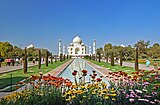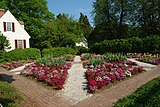Garden

A garden is a planned space, usually outdoors, set aside for the cultivation, display, and enjoyment of plants and other forms of nature. The single feature identifying even the wildest
Gardens often have design features including statuary, follies, pergolas, trellises, stumperies, dry creek beds, and water features such as fountains, ponds (with or without fish), waterfalls or creeks. Some gardens are for ornamental purposes only, while others also produce food crops, sometimes in separate areas, or sometimes intermixed with the ornamental plants. Food-producing gardens are distinguished from farms by their smaller scale, more labor-intensive methods, and their purpose (enjoyment of a hobby or self-sustenance rather than producing for sale, as in a market garden). Flower gardens combine plants of different heights, colors, textures, and fragrances to create interest and delight the senses.[2]
The most common form today is a residential or public garden, but the term garden has traditionally been a more general one.
Landscape architecture is a related professional activity with landscape architects tending to engage in design at many scales and working on both public and private projects.[5]
Etymology
The etymology of the word gardening refers to
The term "garden" in British English refers to a small enclosed area of land, usually adjoining a building.[8] This would be referred to as a yard in American English.[9]
Uses
A garden can have
- Cooperation with nature
- Plant cultivation
- Garden-based learning
- Observation of nature
- Relaxation
- Growing useful produce
- Flowers to cut and bring inside for indoor beauty
- Fresh herbs and vegetables for cooking
History
Asia
China

The earliest recorded Chinese gardens were created in the valley of the
A famous royal garden of the late Shang dynasty was the Terrace, Pond and Park of the Spirit (Lingtai, Lingzhao Lingyou) built by
- The King makes his promenade in the Park of the Spirit,
- The deer are kneeling on the grass, feeding their fawns,
- The deer are beautiful and resplendent.
- The immaculate cranes have plumes of a brilliant white.
- The King makes his promenade to the Pond of the Spirit,
- The water is full of fish, who wriggle.[12]
Another early royal garden was Shaqui, or the Dunes of Sand, built by the last Shang ruler, King Zhou (1075–1046 BC). It was composed of an earth terrace, or tai, which served as an observation platform in the center of a large square park. It was described in one of the early classics of Chinese literature, the Records of the Grand Historian (Shiji).[13] According to the Shiji, one of the most famous features of this garden was the Wine Pool and Meat Forest (酒池肉林). A large pool, big enough for several small boats, was constructed on the palace grounds, with inner linings of polished oval shaped stones from the seashore. The pool was then filled with wine. A small island was constructed in the middle of the pool, where trees were planted, which had skewers of roasted meat hanging from their branches. King Zhou and his friends and concubines drifted in their boats, drinking the wine with their hands and eating the roasted meat from the trees. Later Chinese philosophers and historians cited this garden as an example of decadence and bad taste.[14]
During the Spring and Autumn period (722–481 BC), in 535 BC, the Terrace of Shanghua, with lavishly decorated palaces, was built by King Jing of the Zhou dynasty. In 505 BC, an even more elaborate garden, the Terrace of Gusu, was begun. It was located on the side of a mountain, and included a series of terraces connected by galleries, along with a lake where boats in the form of blue dragons navigated. From the highest terrace, a view extended as far as Lake Tai, the Great Lake.[15]
India
Manasollasa is a twelfth century Sanskrit text that offers details on garden design and a variety of other subjects.[16] Both public parks and woodland gardens are described, with about 40 types of trees recommended for the park in the Vana-krida chapter.[16][17] Shilparatna, a text from the sixteenth century, states that flower gardens or public parks should be located in the northern portion of a town.[18]
Japan
The earliest recorded Japanese gardens were the pleasure gardens of the Emperors and nobles. They were mentioned in several brief passages of the Nihon Shoki, the first chronicle of Japanese history, published in 720 CE. In spring 74 CE, the chronicle recorded: "The Emperor Keikō put a few carp into a pond, and rejoiced to see them morning and evening". The following year, "The Emperor launched a double-hulled boat in the pond of Ijishi at Ihare, and went aboard with his imperial concubine, and they feasted sumptuously together". In 486, the chronicle recorded that "The Emperor Kenzō went into the garden and feasted at the edge of a winding stream".[19]
Korea
Europe

France
Following his campaign in Italy in 1495, where he saw the gardens and castles of Naples, King
The
The French landscape garden was influenced by the English landscape garden and gained prominence in the late eighteenth century.[32][33]
United Kingdom
Before the
Jacobean gardens were described as "a delightful confusion" by
Design
Garden design is the process of creating plans for the layout and planting of gardens and landscapes. Gardens may be designed by garden owners themselves, or by professionals. Professional garden designers tend to be trained in principles of design and horticulture, and have a knowledge and experience of using plants. Some professional garden designers are also
Elements of garden design include the layout of hard landscape, such as paths, rockeries, walls, water features, sitting areas and decking, as well as the plants themselves, with consideration for their
Garden needs of maintenance are also taken into consideration. Including the time or funds available for regular maintenance, (this can affect the choices of plants regarding speed of growth) spreading or self-seeding of the plants (annual or perennial), bloom-time, and many other characteristics. Garden design can be roughly divided into two groups, formal and naturalistic gardens. The most important consideration in any garden design is how the garden will be used, followed closely by the desired stylistic genres, and the way the garden space will connect to the home or other structures in the surrounding areas. All of these considerations are subject to the budget limitations. Budget limitations can be addressed by a simpler garden style with fewer plants and less costly hard landscape materials, seeds rather than sod for lawns, and plants that grow quickly; alternatively, garden owners may choose to create their garden over time, area by area.[34]
-
Chehel Sotoun Garden, Isfahan, Iran
-
Parc de Bagatelle, a rose gardenin Paris
-
Garden of the Taj Mahal, India
-
Example of a garden attached to a place of worship: the cloister of the Abbey of Monreale, Sicily, Italy
-
The Sunken Garden of Butchart Gardens, Victoria, British Columbia
-
Gardens of Versailles (France)
-
Theback garden of the Umaid Bhawan Palace in Jodhpur, India
-
Garden with fountains, Villa d'Este, Italy
-
Gardens at Colonial Williamsburg, Williamsburg, Virginia, feature many heirloom varieties of plants.
-
Zen garden.
Types
| Types of gardens | |
|---|---|
| Specific plant or purpose | butterfly garden, hydroponic garden (growing plants without soil), rain garden (reabsorption of rain run-off), and trial garden (testing and evaluating plants).
|
| Specific style or aesthetic | |
| Placement | |
| Material | raised bed gardening, rock garden, cold frame
|
Environmental impact
Gardeners may cause environmental damage by the way they garden, or they may enhance their local environment. Damage by gardeners can include direct destruction of natural habitats when houses and gardens are created; indirect habitat destruction and damage to provide garden materials such as peat,[35] rock for rock gardens,[36] and by the use of tapwater to irrigate gardens; the death of living beings in the garden itself, such as the killing not only of slugs and snails but also their predators such as hedgehogs and song thrushes by metaldehyde slug killer; the death of living beings outside the garden, such as local species extinction by indiscriminate plant collectors; and climate change caused by greenhouse gases produced by gardening.
Climate change
Gardeners can help to prevent climate change in many ways, including the use of trees, shrubs,
Climate change will have many impacts on gardens; some studies suggest most of them will be negative.
Irrigation
Some gardeners manage their gardens without using any water from outside the garden. Examples in Britain include
See also
- Index of gardening articles
- Outline of organic gardening and farming
- List of professional gardeners
- List of horticulture and gardening books/publications
References
- ^ "Garden". Cambridge Dictionary (Online ed.). Archived from the original on 27 March 2022. Retrieved 21 August 2022.
- ^ Anguelovski, Isabelle. "Urban gardening".
- ISBN 978-1-134-37082-5. Archivedfrom the original on 28 August 2022. Retrieved 8 December 2021.
- ISBN 978-0-8070-8562-2. Archivedfrom the original on 2022-08-28. Retrieved 2021-12-08.
- doi:10.1002/tea.1036.
- Merriam Webster. Archivedfrom the original on 2010-02-21. Retrieved 2009-10-14.
- ^ "Etymology of words referring to enclosures, probably from a Sanskrit stem. In German, for example, Stuttgart. The word is generic for compounds and walled cities, as in Stalingrad, and the Russian word for city, gorod. Gird and girdle are also related". Yourdictionary.com. Archived from the original on 2010-02-13.
- ^ "Oxford Dictionaries". Oxford Dictionaries. Archived from the original on 2007-09-29. Retrieved 2007-05-24.
- ISBN 9781620875773.
- ^ Feng Chaoxiong, The Classical Gardens of Suzhou, preface, and Bing Chiu, Jardins de Chine, ou la quete du paradis, Editions de La Martiniere, Paris 2010, p. 10–11.
- ^ Tong Jun, Records of Jiang Gardens, cited in Feng Chanoxiong, The Classical Gardens of Suzhou.
- ^ Translation in Jardins de Chine, ou la quête du paradis, cited in Che Bing Chiu, Jardins de Chine, ou la quete du paradis, p. 11.
- ^ Tan, p. 10. See also Che Bing Chiu, Jardins de Chine, ou la quete du paradis, p. 11.
- ^ Che Bing Chiu, Jardins de Chine, ou la quete du paradis, p. 11.
- ^ Che Bing Chiu, Jardins de Chine, p. 12
- ^ a b Nalini Sadhale and YL Nene (2010), Bhudharakrida in Manasollasa, Asian Agri-History, Vol. 14, No. 4, pages 319–335
- ^ Shrigondekar 1961.
- JSTOR 43618748.
- ^ Nitschke, Le Jardin Japonais, p. 30.
- ISBN 9780710302991. Retrieved 2009-01-12.
- ^ "Archived copy". Archived from the original on 2011-09-28. Retrieved 2011-05-18.
{{cite web}}: CS1 maint: archived copy as title (link) - ^ Samson, Alexander. Locus Amoenus: Gardens and Horticulture in the Renaissance, 2012 :6
- ^ Samson, Alexander. Locus Amoenus: Gardens and Horticulture in the Renaissance, 2012 :8
- ^ Wenzler, Architecture du jardin, pg. 12
- ^ Philippe Prevot, Histoire des jardins, pg. 107
- ^ Prevot, Histoire des Jardins, 114
- Le Nôtre, Éd. Hazan, p. 17
- ISBN 9781568980508.
- ^ Scurr, Ruth (2022). Napoleon: A Life in Gardens and Shadows. Vintage. p. 15.
- ^ ISBN 978-1849950824.
- ^ Scurr, Ruth (2022). Napoleon: A Life in Gardens and Shadows. Vintage. p. 29.
- ISBN 9783039102914.
- ISBN 9781568980508.
- ^ Chen 2010, p. 3.
- ^ Higgins, Adrian. "Is this popular gardening material bad for the planet?". The Washington Post. Retrieved 29 August 2022.
- ISBN 9780643068667. Retrieved 29 August 2022.
- ISBN 978-1-4051-6063-6.
- S2CID 127801132.
- ISBN 978-0-88192-826-6.
Works cited
- Chen, Gang (2010). Planting design illustrated (2nd ed.). Outskirts Press, Inc. ISBN 978-1-4327-4197-6.
- Shrigondekar, GK (1961). Manasollasa of King Somesvara (Volume 3) (in Sanskrit). Oriental Institute, Baroda.
External links
 Media related to Garden at Wikimedia Commons
Media related to Garden at Wikimedia Commons










